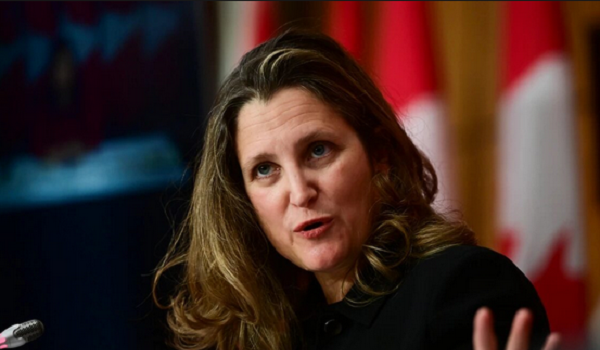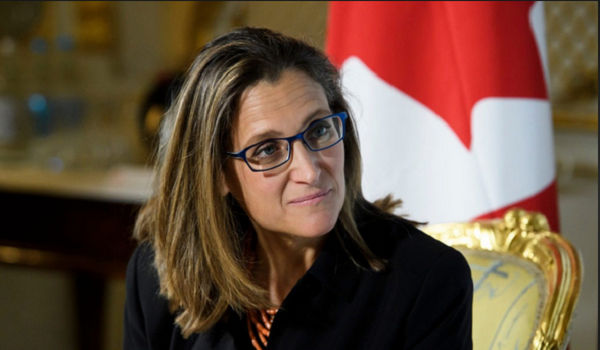Chrystia Freeland to give fiscal update on $15-billion in rental housing loans
The federal government will announce several housing-related measures – including new rental home construction loans and guidelines for homeowners managing looming mortgage renewal shocks – in a slimmed down fall economic statement aimed at responding to affordability concerns that are now central to the Canadian political debate.
Finance Minister Chrystia Freeland will release the economic statement Tuesday afternoon, which will take into account key changes that have occurred since the federal budget in March.
These include a spike in long-term borrowing costs and a significant slowdown in economic growth – two sides of the same coin that are squeezing federal finances and limiting the government’s room for manoeuvre amid persistently high inflation.
According to a senior government official, the update will announce $15-billion in 10-year low-cost loans that the Canada Mortgage and Housing Corp. will provide to builders of new rental properties. Unlike direct grants, loans are expected to be repaid and come with little fiscal cost to the government.
There will also be $1-billion in direct spending on affordable housing. And the update will also announce a “Canadian mortgage charter” aimed at helping homeowners navigate a looming payment shock over the next three years as Canadians face a wave of renewals at much higher rates.
The Globe and Mail is not identifying the official as they were not authorized to comment on the record about the details of the update.
The update will also include restrictions on short-term rentals, the official said. Owners of short-term rentals, such as Airbnb properties, will no longer be able to deduct expenses for the short-term rental property if it’s in an area where a province or municipality has prohibited such rentals.
The thinking is that such a move could boost supply by unlocking underused housing.
Housing affordability has become a major political liability for the Liberal government. While the overall rate of inflation has fallen significantly over the past 1½ years, home ownership costs and rental rates continue to rise quickly.
Part of this has to do with a chronic shortage of housing supply, which has been exacerbated by a surge in immigration over the past two years.
The Bank of Canada’s aggressive monetary policy tightening campaign has also pushed mortgage costs to the highest level in decades. This has not been balanced out by a drop in home prices.
So far, around 40 per cent of Canadian homeowners with mortgages have seen their payments reset higher. A recent RBC Capital Markets report said an estimated $900-billion worth of Canadian mortgages held by Canada’s chartered banks are due to renew between 2024 and 2026, likely at much higher rates given current borrowing costs.
The mortgage charter, which will be announced Tuesday, is broadly in line with guidelines published earlier this year by the Financial Consumer Agency of Canada. Essentially, the charter sets expectations and clarifies rules for Canadians in dealing with a mortgage renewal.
For instance, it will state that lenders must notify mortgage holders four to six months in advance of their renewal date. The charter also emphasizes the agency’s expectations that lenders should have appropriate mortgage relief policies for at-risk consumers, such as extending amortizations.
Conservative Leader Pierre Poilievre highlighted the looming wave of mortgage renewals Monday at a news conference urging Ms. Freeland to trim spending in order to ease inflation and allow interest rates to come down.
“There will be a massive mortgage crisis if rates do not come down,” he said. “Do the compassionate thing … balance the budget to bring down interest rates and inflation.”
On affordability, the update is expected to include competition-related changes that go beyond the measures announced in September through Bill C-56, the Affordable Housing and Groceries Act.
In another area, Indigenous and business leaders who have been urging Ottawa to approve a federal loan-guarantee plan for major resources projects say they hope Tuesday’s update will provide an indication as to whether the government is open to the idea.
The fall economic statement will also need to account for a string of other spending and taxation changes since the spring budget. These include billions in subsidies for two electric vehicle battery manufacturing plants in Ontario, a large wage settlement with federal employees and an enhanced GST rebate for rental home construction.
A report released last month by Parliamentary Budget Officer Yves Giroux said the federal deficit is on pace to exceed $46-billion this year, which is $6-billion more than projected in the March budget.
The macroeconomic environment is changing quickly. Government revenues came in stronger than expected last year, and there was a surprising burst of economic activity in the first quarter of this year. Since then, however, gross domestic product growth has flatlined under the weight of higher interest rates – a dynamic that will put downward pressure on government tax revenues over time.
Borrowing costs have also moved higher, despite the decline in inflation over the past year and a half. The Bank of Canada hiked rates two more times over the summer, bringing its policy rate to a 22-year-high. Long-term borrowing costs, which are determined in bond markets, have surged since the March budget as financial markets bet interest rates will remain higher for longer. Federal government debt-service costs were up 35 per cent over the first eight months of the year compared with the year before, from around $20.8-billion to $28.2-billion.
Ms. Freeland’s ability to respond to slowing growth is limited by inflation. Growth in government spending, at all levels of government, is adding to demand in the economy and putting upward pressure on consumer prices. Bank of Canada Governor Tiff Macklem told the House of Commons finance committee earlier this month that fiscal policy was making his job harder. “It would be helpful if monetary and fiscal policy was rowing in the same direction,” Mr. Macklem said.
Robert Asselin, senior vice-president of policy with the Business Council of Canada and a former economic adviser to the Trudeau government, said the fiscal track announced Tuesday is far more important than any new policy measures that may be announced.
“It looks like they want to frame this thing around housing, which is a distraction, I think, from the fiscal picture,” he said.
Financial markets will be watching to see whether the government further stretches its “fiscal anchor” – a commitment to keep the federal debt relative to the size of the economy on a downward trajectory over the medium term. The spring budget showed the country’s debt-to-GDP ratio rising in the 2023-2024 fiscal year before slowing ticking down over the next four years.
Rebekah Young, Bank of Nova Scotia’s vice-president, head of inclusion and resilience economics, said that overall debt levels remain manageable in Canada when compared to peer countries. But the government should be careful that it doesn’t press its luck with bond investors and rating agencies by perpetually pushing back the timeline for getting its debt levels back onto a downward track, Ms. Young said.
“Technically debt is sustainable if it continues to climb down over the horizon. But that involves credibility. … And the more times [the federal government] has this rolling hump in the debt profile, then they start to lose some of that credibility,” she said.
This article was reported by The Globe and Mail
















